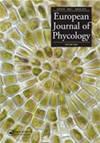两种小型Chaetoceros物种(Bacillarophyta)的分类学关系:细毛毛毛犀和萨尔苏吉奈毛犀,以及与加泰罗尼亚沿海水域(地中海西北部)奥林匹克毛犀的比较
IF 1.7
4区 生物学
Q2 MARINE & FRESHWATER BIOLOGY
引用次数: 2
摘要
摘要高度多样化的毛犀属的大多数物种都被描述为链状,尽管有几个物种被描述为严格孤立的(如细毛犀)或在其生活史上具有交替的孤立和链状阶段(如萨尔苏犀)。在这项研究中,通过属于两个不同物种的四个不同菌株的形态和分子特征,探索了地中海西北部沿海水域小型角犀的多样性。根据它们的形态,其中三个菌株被鉴定为C.salsugineus(Takano,1983)。SSU和LSU rDNA序列代表了第一个可用于特征良好的C.salsugineus菌株的序列,与可公开获得的C.tenuissimus(Meunier,1913)序列具有96.6–100%的相似性。这两个物种都有相同的形态特征,如刚毛和瓣膜的超微结构,以及边缘孔的特征。此外,沙杉的单生形态与细茎沙杉的形态相匹配。在这里,我们提出这两个物种作为同义词(C.tenuissimus这个名称占主导地位,因为它对这个分类单元有优先权),修改了原始描述并指定了一个表型。第四个菌株被鉴定为奥林匹克C.olympicus sp.nov.,这是一个新物种,在其生命史中交替出现孤立和连锁形式。该种的主要差异特征是在顶瓣和瓣间都没有缘孔,刚毛的超微结构,横截面薄而圆形,有一些轻微扭曲的小矩形孔和一些螺旋排列的刺,以及休眠孢子的形态,初级阀拱形并覆盖有短到中等大小的刺,次级阀较小,圆形和光滑。此外,还提供了细叶C.tenuissimus和奥林匹克C.olympicus与其他物种的比较,以及它们的生命周期和生态学信息。亮点•一个新的毛犀物种的描述:奥林匹克毛犀。•提出细叶C.tenuissimus和狭叶C.salsugineus是同义词。•生命周期中形态变异对物种鉴定的重要性。本文章由计算机程序翻译,如有差异,请以英文原文为准。
Taxonomic relationship between two small-sized Chaetoceros species (Bacillariophyta): C. tenuissimus and C. salsugineus, and comparison with C. olympicus sp. nov. from Catalan coastal waters (NW Mediterranean)
ABSTRACT The majority of species of the highly diverse genus Chaetoceros are described as chain-forming, although several species are described as strictly solitary (such as C. tenuissimus) or having an alternate solitary and a chain-forming phase during their life history (such as C. salsugineus). In this study, the diversity of small forms of Chaetoceros from the NW Mediterranean coastal waters was explored through the morphological and molecular characterization of four different strains belonging to two distinct species. Based on their morphology, three of the strains were identified as C. salsugineus (Takano, 1983). The SSU and LSU rDNA sequences represented the first available for well-characterized C. salsugineus strains and were 96.6–100% similar to publicly available C. tenuissimus (Meunier, 1913) sequences. Both species share the same morphological features, such as setae and ultrastructure of the valves, as well as the rimoportula characteristics. In addition, the morphology of the solitary form of C. salsugineus matched with that of C. tenuissimus. Here, we propose the two species as synonyms (the name C. tenuissimus prevailing as it has priority for this taxon), emend the original description and designate an epitype. The fourth strain was identified as C. olympicus sp. nov., a new species, which alternates solitary and chain-forming forms within its life history. The main differential characteristics of this species are the absence of rimoportula both in terminal and intercalary valves, the setae ultrastructure, which is thin and circular in cross-section with a few, slightly twisted, rows of small rectangular poroids and some spirally arranged spines, and the morphology of the resting spores, with primary valve vaulted and covered with short to medium-sized spines, and secondary valve smaller, rounded and smooth. A comparison of C. tenuissimus and C. olympicus with other species as well as information on their life cycle and ecology is also provided. HIGHLIGHTS • Description of a new Chaetoceros species: C. olympicus. • Proposal that C. tenuissimus and C. salsugineus are synonyms. • Importance of morphological variability in life cycles for species identification.
求助全文
通过发布文献求助,成功后即可免费获取论文全文。
去求助
来源期刊

European Journal of Phycology
生物-海洋与淡水生物学
CiteScore
4.80
自引率
4.20%
发文量
37
审稿时长
>12 weeks
期刊介绍:
The European Journal of Phycology is an important focus for the activities of algal researchers all over the world. The Editors-in-Chief are assisted by an international team of Associate Editors who are experts in the following fields: macroalgal ecology, microalgal ecology, physiology and biochemistry, cell biology, molecular biology, macroalgal and microalgal systematics, applied phycology and biotechnology. The European Journal of Phycology publishes papers on all aspects of algae, including cyanobacteria. Articles may be in the form of primary research papers and reviews of topical subjects.
The journal publishes high quality research and is well cited, with a consistently good Impact Factor.
 求助内容:
求助内容: 应助结果提醒方式:
应助结果提醒方式:


